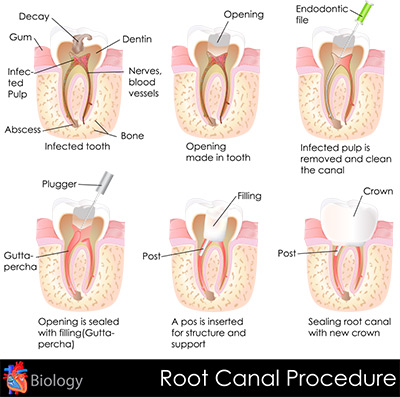Root Canals
What Is a Root Canal?

Under a tooth’s outer enamel and contained in the dentin is an area of soft tissue. This tissue is called the pulp tissue. A tooth’s pulp tissue contain nerve fibers as well as arteries, veins, lymph vessels, and connective tissue. The nerve runs through the center of the root in small “root canals”. Root canals are small, thin divisions that branch off from the top pulp chamber down to the tip of the root.
Why do I need root canal therapy?
A tooth will not heal by itself. Often, root canal therapy is an effective alternative to extraction. If a problem tooth is not treated, infection will spread, bone around the tooth will begin to degenerate and the tooth may fall out. Extraction of the tooth can cause surrounding teeth to shift resulting in a bad bite. Root canal therapy would remove the infected areas around the nerves; reducing inflammation and effectively saving the tooth. Though an extraction is cheaper, the space left behind will require an implant or a bridge, which can be more expensive than root canal therapy.
What is involved in root canal therapy?
Usually, a local anesthetic is used to numb the area. The tooth is isolated and a an opening is drilled from the crown into the pulp chamber. The root canal, is cleaned of all diseased pulp and reshaped. Medication may be inserted into the area to fight bacteria. The crown may then be sealed temporarily to guard against recontamination, the tooth may be left open to drain or the dentist may go right ahead and fill the canals. If you’re given a temporary filling, usually on the next visit it’s removed and the pulp chamber and canal(s) are filled. If the tooth is still weak, a metal post may be inserted above the canal filling to reinforce the tooth


